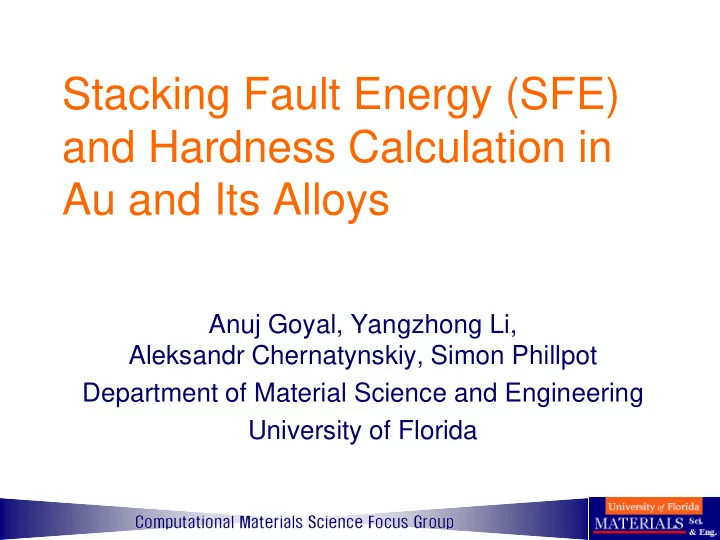

Stacking Fault Energy (SFE) and Hardness Calculation in Au and Its Alloys Anuj Goyal, Yangzhong Li, Aleksandr Chernatynskiy, Simon Phillpot Department of Material Science and Engineering University of Florida
2 Outline and Previous Task • Surface orientation simulation (pg 3, 4) • Compare H and E for (111), (100) and (110) surface • GB orientation simulation (pg 5) • Compare H in two different GB orientation • Characterize twinning during indentation • SFE from multiple potentials (pg 6,7) • H vs SFE plot (pg 8-11)
3 Surface Orientation Simulation Surface Plastic H Yield H Exp Yield H E Exp E (111) 5.40 ± 0.25 7.24 7.3 ± 0.5 88.7 78 ± 1 85 ± 7 5.18 ± 0.39 7.21 89.3 (100) 6.91 ± 0.28 7.34 5.5 ± 0.4 77.7 57± 3 7.06 ± 0.17 7.48 80.8 (110) 5.02 ± 0.25 5.96 7.8 ± 0.7 81.9 82 ± 6 5.21 ± 0.23 5.74 80.8 • EAM: (111) ~ (100) > (110) • Exp: (111) ~ (110) > (100) Exp ref: J Kiely and J Houston, PRB 57, 12588 (1998)
4 Mechanism of Au Hardening • (111): generates many SF inter-blocking (111) Side (111) Bottom each other to provide hardening (100) Side (100) Bottom (110) Side (110) bottom • (100): generates and emits the 4- side loop to provide continuous hardening • (110): generates defect in a smaller scale; weaker hardening
5 GB Orientation Simulation • 60º GB forms dense twinning Twinning planes (parallel double SFs) layers to provide hardening • 30º GB forms sparse, non-blocking SFs; no twinning, no hardening • GB makes defect nucleation easier thus decrease yield H 60 side 60 top GB orientation Plastic H Yield H 30 side 30 top 60 º 5.30 ± 0.54 6.21 5.76 ± 0.21 6.19 30 º 4.96 ± 0.44 5.70 4.85 ± 0.32 5.46 0º (no GB) 5.40 ± 0.25 7.24 5.18 ± 0.39 7.21
6 6 SFE Calculation: Slab Method • Use vacuum (100 Å ) along shear Z axis vacuum vacuum Z ε vacuum vacuum J. A. Zimmerman, H. Gao et al., Modelling Simul. Mater. Sci. Eng. 8 (2000) 103–115
7 SFE of Pure Au • Only two EAM potentials are able to perform alloying simulation EAM-potential Stable SFE (mJ/m 2 ) Alloying elements Ward (2012) 3.55 FCC(Ag, Al, Cu, Ni) HCP(Ti, Zr) Zhou (2004) 4.18 FCC(Ag, Al, Cu, Ni, Pb, Pd, Pt) BCC(Fe, Mo, Ta, W) HCP(Co, Mg, Ti, Zr) Sheng (2011) 49.9 No Foiles (1986) 4.72 No Exp (1972) 32 ± 5 DFT 28 L Ward, arXiv:1209.0619 X Zhou, PRB 69, 035402 (2004) H Sheng, PRB 83, 134118 (2011) S Foiles, PRB 33 7983 (1986) M Jenkins, Phil Mag 26, 747 (1972)
8 Stable SFE vs. Concentration • SFE calculation shows great variations and sometimes results in negative values • Methods are being refined to improve the result 60 50 40 30 Ag SFE (mJ/m2) 20 Al Cu 10 Ni 0 0% 1% 2% 3% 4% 5% 6% Ti -10 Zr -20 -30 -40 Concentration
9 Correlation between H and SFE • Two independent variable • Element (ele), concentration (con) • Two dependent variable • H(ele, con), SFE(ele, con) • Two analysis performed • Fix con, plot H(ele) vs. SFE (ele) • Fix ele, plot H(con) vs. SFE (con)
10 H vs SFE under Fixed Concentration • 1% shows a strong negative correlation; but quantitative relation cannot be drawn due to large variation 7.5 7 6.5 Plastic H GPa) 1% 6 2% 3% 5.5 5% 5 4.5 -35 -25 -15 -5 5 15 25 35 45 SFE (mJ/m2)
11 H vs SFE under Fixed Elements • Ag, Ni and Ti shows a negative correlation 9 8.5 8 Plastic H (GPa) Ag 7.5 Al Cu 7 Ni Ti 6.5 Zr 6 5.5 -40 -20 0 20 40 60 SFE (mJ/m2)
12 Conclusion • EAM is able to consistently correlate H variation and defect generation, despite the actual H different from experiment • GB decrease yield H, and provide hardening by generating twinning SF • Only 2 EAM potentials are suitable for alloying simulation; EAM-zhou is currently running • Due to high variation of SFE by EAM-ward potential, only qualitative trend can be drawn • Currently running indentation and SFE calculation by EAM-zhou potential; preliminary SFE results show variation with much smaller magnitude
Recommend
More recommend